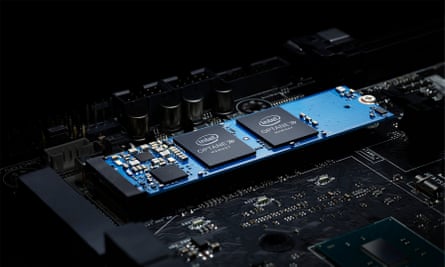I’m looking to replace my eight-year-old desktop PC. Other things being equal, should I go for an AMD processor with a 128GB SSD or an Intel PC with 8GB of memory, a 1TB HDD and Optane? A comparison of processor performance shows very little difference, and the two options have very similar prices.
I typically run a browser with multiple tabs, Acrobat Reader with large pdf files, one or more of the Microsoft Office suite, plus the proprietary software for my business. I don’t do high-end graphics processing or gaming, but would your advice be different if I did? Ruth
The difference between the two PCs boils down to how much storage you need and the performance of the Optane accelerator in the Intel-based machine.
Most buyers have to choose between expensive but fast SSDs (solid-state drives) and cheaper, slower but much larger HDDs (hard disk drives). I answered this question in June (What is the best laptop drive for students?), providing some background on the different technologies used.
Reading it now might help, but to summarise, the best answer for most laptop users is an SSD. Ideally, it should be an M.2 module with NVM Express (NVMe) drivers and controllers, rather than the traditional SSD that fits into a standard drive bay and uses a SATA connection. However, any SSD will do the job well.
Desktop PC users have other options, with Optane accelerators being one of the most cost-effective. I use one myself.
Basically, Optane provides a high-speed cache between the processor and the HDD. This increases the responsiveness of your PC, giving you close to SSD speeds at HDD prices.
How much storage?
Desktop PC users typically want to have masses of data readily available, including decades-worth of documents, photos, music and video files. These won’t fit on an affordable SSD, so desktops often have 1TB or larger HDDs.
If you have too much data for an SSD, one option is to fit a second internal hard drive, so make sure the PC you buy has at least one empty drive bay. You can also store data and backups on external hard drives or online, but both are much slower than using an internal drive.
The other option is to add an Optane cache to accelerate a traditional hard drive. There are some limitations, but in general, this should outperform a SATA-style SSD in a drive bay. You can get the best of both worlds.
What is Optane?
Optane is a new type of memory chip developed in secret by Intel and Micron in a partnership that will end next year. They call the technology 3D XPoint (cross point). It might be an example of ReRAM (resistive random-access memory), but don’t quote me on that. It’s certainly different.
3D XPoint chips fit into the gap between standard memory chips (RAM) and the Flash memory chips used in SSDs. 3D XPoint chips are slower and cheaper than RAM chips, but dramatically faster and costlier than SSD chips.
Over the long term, more advanced 3D XPoint chips will replace RAM chips for some purposes (Intel has already announced 512GB memory modules) and Flash chips for other purposes.
Intel sells 3D XPoint devices under the Optane brand label while Micron uses QuantX.

Intel has taken the lead partly because it can manufacture processors, support chips and motherboards that work with Optane. Specifically, Optane requires a seventh- or eighth-generation Intel Core processor, a motherboard with recent Intel support chips (eg Z270 or Z250), Intel RST (Rapid Storage Technology) V15.5 or later drivers, and a GPT formatted hard drive, not MBR (PDF).
The latest version of Optane works with secondary hard drives, not just 64-bit Windows 10 boot drives. This is a useful step forward. Unfortunately, it requires an eighth-generation Core processor and a motherboard with Intel Series 300 or later support chips.
Using Optane accelerators
You can buy Optane accelerators and SSDs in the usual places, but getting them to work properly can be another matter. Even if you have a compatible PC, you may need to update the BIOS/UEFI firmware and download new drivers. It’s simpler to buy a new desktop PC with Optane pre-installed.
However, people who need the maximum performance from their PCs could think about buying an Optane SSD. Intel’s 280GB Optane 900P SSD sells for around £360 and outperforms other M2 SSDs by a significant margin. It should also last much longer. Sadly, it’s more than four times the price of a 250GB Samsung M2 SSD (around £80), and nine times the price of a 240GB SanDisk SATA SSD (around £40).
Given the price of Optane SSDs, most users will settle for 16GB or 32GB M.2 modules installed as caches, using the Intel management software supplied. The first time you run a program or load data, you won’t see any difference. Loading programs again is extremely fast, because they are being loaded from the Optane cache.
In my experience with a 1TB hard drive and a 16GB Optane cache, performance is comparable with a traditional SATA SSD and approaching that of an M.2 SSD, for most normal purposes.
Optane chips are “non-volatile” so, unlike RAM chips, they remember whatever they are storing even if you turn the power off.
You don’t have to worry about which programs and data are cached because the software manages that automatically.
However, you may have problems if you run so many different programs that they won’t fit into the cache available. Someone who runs a lot of multi-level AAA games might well be in that position. Someone who regularly throws 16GB data files around may not see many benefits from Optane, and may suffer slowdowns due to cache swapping.
Your use sounds much like mine. I typically run two browsers with around 50 to 250 tabs and one or two Microsoft Office programs, which are lightweights by today’s standards. I also do some photo and video editing. Given my predictable usage, Optane works very well. If I did run into problems, I think I could solve them by swapping the 16GB module for a 32GB version.
However, someone who uses very large programs and/or large data files might well be better off with a 256GB or larger SSD than a cached hard drive. Also, the more unpredictable you are, the worse it is for any cache.
The most cost-effective compromise might be a SATA SSD for the boot disk with an Optane-accelerated secondary HDD. Please comment below if you’ve done that.
Speed tests
I admit to being sceptical about Optane memory before I tried it. It wasn’t on my list as a required specification. It just happened to be included in a Dell XPS Core i5-8400/8GB PC that had the specs I wanted at an attractive price (£699), and I assumed it couldn’t do any harm.
If it didn’t work well, I could always install a cheap SSD and use the built-in HDD as a secondary drive. (Yes, Optane will speed up an SSD!)
Having used it for 10 months without running into any problems, I can recommend it. However, I haven’t done any serious speed tests. Others have.
For example, TweakTown has tested a 32GB Optane cache in great depth, while AnandTech has tested this year’s 64GB module. Both make useful comments.
TweakTown and Tom’s Hardware reinforce the point that we don’t spend much time copying sequential files, which is how people often test drive speeds. Most of the time, we’re doing random-access reads. That is where SSDs are at their weakest, and Optane is at its strongest.
Have you got a question? Email it to Ask.Jack@theguardian.com

Comments (…)
Sign in or create your Guardian account to join the discussion